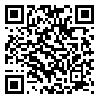Volume 13, Issue 3 (Vol.13, No.3, Atumn 2017)
irje 2017, 13(3): 183-189 |
Back to browse issues page
1- MSc Student in Biostatistics, Modeling in Health Research Center, Institute for Futures Studies in Health, Kerman University of Medical Sciences, Kerman, Iran
2- Modeling in Health Research Center, Institute for Futures Studies in Health, Kerman University of Medical Sciences, Kerman, Iran ,rbaneshi2@gmail.com
3- Modeling in Health Research Center, Institute for Futures Studies in Health, Kerman University of Medical Sciences, Kerman, Iran
4- HIV/STI Surveillance Research Center, and WHO Collaborating Center for HIV Surveillance, Institute for Futures Studies in Health, Kerman University of Medical Sciences, Kerman, Iran
2- Modeling in Health Research Center, Institute for Futures Studies in Health, Kerman University of Medical Sciences, Kerman, Iran ,
3- Modeling in Health Research Center, Institute for Futures Studies in Health, Kerman University of Medical Sciences, Kerman, Iran
4- HIV/STI Surveillance Research Center, and WHO Collaborating Center for HIV Surveillance, Institute for Futures Studies in Health, Kerman University of Medical Sciences, Kerman, Iran
Abstract: (7310 Views)
Background and Objectives: We may sometimes measure the joint effect of correlated independent variables on several dependent variablesThe present study aimed to evaluate the performance of multivariate analysis of variance (MANOVA) and structural equation modeling (SEM) on complex relationships between variables.
Methods: The present study evaluated the knowledge and attitude of 15-18 year-old individuals towards narcotics (glass, ecstasy). The effect of independent variables on two latent variables of knowledge and attitudes was studied using SEM and MANOVA modelingThe mean square error of methods were compared.
Results: The direction of associations was similar in both methods but their coefficients and p-values were different. only the effect of gender (P-value= 0.007) on knowledge in both methods was significant. Nevertheless, gender (P-value < 0.001) and marital status (P-value< 0.001) were significantly associated with attitude in both methods. The mean square error of multivariate analysis of variance and structural equation modeling was 0.98 and 0.002 respectively.
Conclusion: In the current studythe performance of SEM was better than MANOVA. Therefore, it is suggested that SEM to be used to study the multifactorial relationship between variables. In addition, only gender was effective on knowledge in both methods, while gender and marital status were effective on attitude in both methods.
Methods: The present study evaluated the knowledge and attitude of 15-18 year-old individuals towards narcotics (glass, ecstasy). The effect of independent variables on two latent variables of knowledge and attitudes was studied using SEM and MANOVA modelingThe mean square error of methods were compared.
Results: The direction of associations was similar in both methods but their coefficients and p-values were different. only the effect of gender (P-value= 0.007) on knowledge in both methods was significant. Nevertheless, gender (P-value < 0.001) and marital status (P-value< 0.001) were significantly associated with attitude in both methods. The mean square error of multivariate analysis of variance and structural equation modeling was 0.98 and 0.002 respectively.
Conclusion: In the current studythe performance of SEM was better than MANOVA. Therefore, it is suggested that SEM to be used to study the multifactorial relationship between variables. In addition, only gender was effective on knowledge in both methods, while gender and marital status were effective on attitude in both methods.
Keywords: Multivariate analysis of variance (MANOVA), Structural equation modeling, Information, Attitude, Glass, Ecstasy
Type of Study: Research |
Subject:
General
Received: 2017/11/29 | Accepted: 2017/11/29 | Published: 2017/11/29
Received: 2017/11/29 | Accepted: 2017/11/29 | Published: 2017/11/29
| Rights and permissions | |
 |
This work is licensed under a Creative Commons Attribution-NonCommercial 4.0 International License. |


